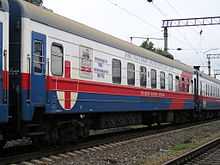Hospital train

A hospital train is a railway train with carriages equipped for the provision of healthcare. Historically this has ranged from trains equipped to transport wounded soldiers, with basic nursing and first aid facilities on board, to fully equipped mobile medical centres, sometimes including operating theatres and nursing wards.
Hospital trains in history
Hospital trains began historically as troop trains, whose passengers were restricted to the wounded and dying. These trains had little or nothing in terms of medical facilities, but nurses traveled with the wounded, and the carriages of the trains were painted with red crosses, indicating their humanitarian role, to prevent enemy attack. Such trains were able to connect with hospital ships at French channel ports in order to repatriate wounded British soldiers during the first world war. There are numbers of extant journal entries from those who experienced the hospital trains of this era, many being referred to as "Great White Hospital Trains", as the carriages were often painted white or red and white.[1]
The Sovereign Military Order of Malta
The Sovereign Military Order of Malta (SMOM), which is a sovereign entity (similar to an independent country, though with virtually no land), has a history of operating hospital trains through its military branch, known as the Military Corps of the Order. The operation of such trains reached its peak in the Second World War, but SMOM continues to operate such trains today.[2] These include trains of carriages to provide shelter to refugees, with basic medical provision, and more technically equipped trains, on which a wide range of medical services may be provided.
Lifeline Express
The Lifeline Express is an example of a modern hospital train of a highly technologically advanced type. Operated by the Impact India Foundation since 1991, these trains have had a profound impact on Indian rural healthcare provision.[3] Operating in India, across the extensive network of the Indian Railways, the Lifeline trains (known colloquially as 'magic trains') move from town to town, remaining in a siding or platform at each town's railway station for perhaps a week or so, and providing advanced medical services (often beyond the capabilities of local medical centres) to those who apply for them, through a simple vetting or triage process, which ensures services are provided to those most likely to benefit. These trains include nursing wards, and full-scale operating theatres. They have resident medical and nursing staff, but for surgical procedures they rely upon the charitable provision of time and talents by Indian surgeons who spend some of their free time on board the trains for that purpose.
Chinese eye hospital trains
The state-owned China Railways company currently operates four eye hospital trains, the fourth and latest being operated through the China South Locomotive and Rolling Stock Industry (Group) Corporation, and having entered service in early 2009 for the benefit of residents of the Sichuan Province. A range of ophthalmic surgeries, including the common cataract removal operation, can be provided free of charge on board the trains.[4]
Gallery
-

Hospital train cars parked on the grounds of the VIIIth Mobilization Center of Italian Red Cross, near Marina di Massa, Tuscany
-
Terapevt Matvey Mudrov, a train-based mobile medical center of Russian Railways
-

A hospital train car in Russia's National WWII Museum
-

United States Army Medical Kitchen car at the United States Army Medical Department Museum
See also
References
| Wikimedia Commons has media related to Ambulance trains. |
- ↑ See here for one example of an extensive journal entry from the first world war hospital trains in Europe.
- ↑ Ordine di Malta - Sito Ufficiale - Archivio Fotografico (Italian)
- ↑ See the Impact India website here.
- ↑ "CSR rolls out eye hospital train". Railway Gazette International. 18 March 2009.
